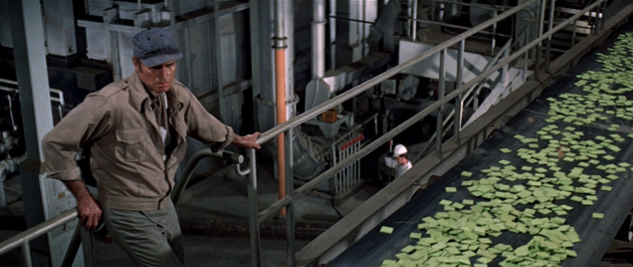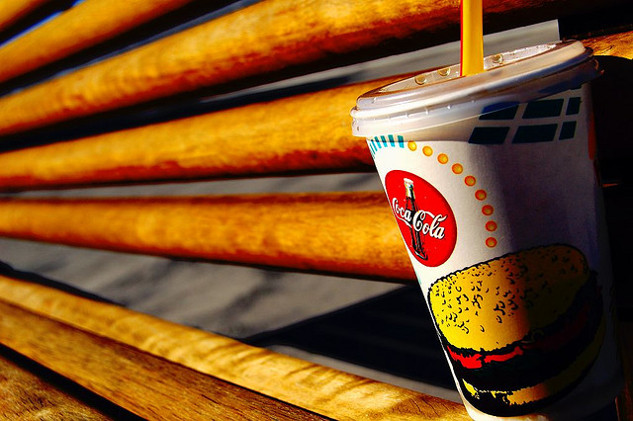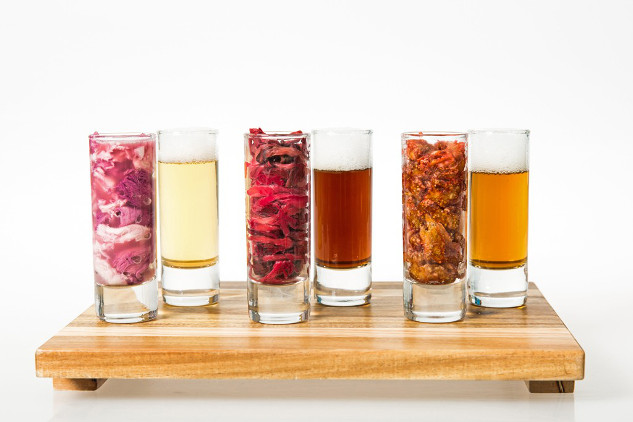The Dystopian Future of Food: How Close Will Reality Be to Science Fiction?
Food Features science fictionFood is cheaper than it’s ever been—Americans only spend about 10 percent of their disposable income on food—and there seems to be plenty to go around. That seems like good news for the future of food in America, but statistics paint a different, more dismal, picture. Nearly 70 percent of Americans are overweight or obese, and one in three people in this country will develop diabetes. Only two percent of harvested acreage in the United States is dedicated to producing vegetables. The proliferation of corn and soy farming due to federal subsidies has flooded the American grocery store with processed foods to the point where many families cannot even access fruits and vegetables, and the result is that 23.5 million people live in food deserts (usually poor, urban or rural areas where there are few grocery stores with fresh food). 48.1 million Americans live in food insecure households. Looking at these statistics, the future of food in America starts to look more like a dystopian sci-fi film than the land of plenty.
Post-apocalyptic literature and film often grapple with the idea of food shortages, but reading the nonfiction works of Michael Pollan, Marion Nestle and the like make it seem like these doomsdays depictions may be closer to reality than fantasy. Margaret Atwood, author of award-winning dystopian novels like The Handmaid’s Tale and Oryx and Crake, rejects the idea that her work is science fiction, telling The Guardian, “Science fiction has monsters and spaceships; speculative fiction could really happen. For me, the science fiction label belongs on books with things in them that we can’t yet do…. speculative fiction means a work that employs the means already to hand and that takes place on Planet Earth.”
Some argue that Atwood and other’s work would fall into the subcategory of science fiction “social science fiction.” Social fiction places more emphasis on the speculation about human society rather than on the nitty-gritty details of the post-apocalypse. It absorbs and discusses anthropology, contemplating the impact of the utopian, dystopian, alternative universe on human behavior and interactions, often making social commentary on our current behaviors, values, or ethics.
Are the food-related, dystopian stories of literature and film closer to speculative fiction than science fiction? How likely is it that the plots of our favorite sci-fi—or, ahem, spec-fi—will unfold in the future? And, most importantly, how accurate are the embedded social commentaries in such media?
“Soylent Green is people!”

“The act of eating is a task that technology can make more efficient—or eliminate entirely” is not a line out of science fiction; it is a quote from Rob Rhinehart, creator of a liquid food substitute called Soylent. The name is a cheeky reference to the 1973 film Soylent Green, starring Charlton Heston as an investigator who discovers that the company monopolizing the world’s manufacture of food substitute uses human flesh as a main ingredient. (Rhinehart’s investors—and mom—have advised him to change the name of his own, non-fiction product.)
The idea of meal replacement has been around for centuries. The Greeks dreamed of ambrosia, “the food of the gods,” that would grant immortality to its consumer. In the Book of Exodus, the Israelites sustained themselves on manna, “a layer of flakes like frost on the ground,” which Yahweh provided to them as they journeyed through the desert to escape their lives of slavery in Egypt. In the 19th century, Victorians wrote of a meal in a pill. In popular culture, The Jetsons ate food pills that produced delicious taste sensations (but sometimes indigestion), and in Ray Bradbury’s The Martian Chronicles, a character keeps several weeks’ worth of food pills in a matchbox.
The idea behind Soylent is not to replace all meals entirely—just the day-to-day, quick-prep sustenance that many turn to junk food for. Soylent is your daily nourishment, and what Rhinehart calls “recreational food” is just for social occasions. His design was inspired by the busy working bachelor, but recognizes its potential to serve the 48.1 million that go hungry in the U.S. Rhinehart means to tap into both our Western fast-paced culture and a growing rejection of processed and fast foods.
Movements like Slow Food argue that the prevalence of fast food is contributing to the destruction of food culture. Soylent doesn’t destroy food culture; it eliminates it entirely. But what would the world look like if we all ate the same thing? So much of our lives and culture revolves around food—how it is prepared, when and where it is eaten, and regional palette preferences. Imagine a world without the rich, spiced tandoori masala of Northern India, perfectly crisp tomatoes on a Neapolitan-style margherita pizza, or the Ethiopian stew shiro served on sour and spongy injera flatbread.
Maybe it’s just because of its unfortunate name, but the new product, Soylent, seems less like a practical solution for busy professionals than a creepy 21st century reminder of the food wafers distributed to starving masses in the movie Soylent Green. However, that nutritional wafer wasn’t a carefully crafted combination of essential molecules and minerals. After the investigation of the disappearance of an older man, Heston’s Detective Thorn makes a desperate revelation. “You’ve gotta tell ‘em! Soylent Green is people!” The threat of resource depletion and food shortage is a common plot driver for dystopian fiction, and the horrifying final solution is often, as it was in Soylent Green, cannibalism.
“Infants’ flesh will be in season throughout the year.”

Although there have been isolated, albeit numerous, instances of real-world cannibalism, our current moral and ethical values are not, uh, advanced enough for this to be one of the more likely sci-fi plots to unfold as a future of food. But for the sake of pop culture, let’s indulge.
In 1729, Jonathan Swift anonymously wrote “A Modest Proposal,” a satirical recommendation to poor Irish families to sell their children as food for the wealthy. This work of social science satire comments on the mercantilism of the 18th century, labor conditions including child labor laws (or lack there of), and the stark income disparity in Ireland (Swift himself was Irish).
The Propagation of Swines Flesh, and Improvement in the Art of making good Bacon, so much wanted among us by the great destruction of Pigs, too frequent at our Tables, which are no way comparable in Taste, or Magnificence to a well grown, fat Yearling Child, which Roasted whole will make a considerable Figure at a Lord Mayor’s Feast, or any other Publick Entertainment.
Returning to the world of fiction, the 1991 film Delicatessen is set in a dilapidated apartment building in post-apocalyptic France, where food is in short supply. The resident butcher advertises for work to lure in victims to slaughter and sell to the tenants as cheap meat. In The Matrix, humans are grown synthetically in pods and fed the liquefied remains of other humans, pumped in through umbilical cords.
Back to reality, human cannibalism may be almost entirely confined to fiction (and the occasional serial killer or remote tribe in Papua New Guinea), but the degradation of animals’ dignity in modern-day factory farms has included forced acts of cannibalism. The outbreaks of mad cow disease, or bovine spongiform encephalopathy, in the early 21st century was the result of cattle being fed the remains of other cattle. Eight variations of this disease exist among human cannibals as well. 2013’s horror film We Are What We Are sensationalized one of these diseases, kuru. The lesson from these human attempts to fatten up our dinner-bound steaks with their own bovine siblings seems to be that cannibalism, in any form, isn’t such a good idea.
Frankenmeat: “It’s alive, it’s alive!”
In a 1932 essay, Winston Churchill made predictions about the future. “Fifty years hence we shall escape the absurdity of growing a whole chicken in order to eat the breast or wing by growing these parts separately under a suitable medium.” He may have missed the mark on the year, but artificial meat is now at the center of discussions of the future of food.
The idea of our meat coming from a laboratory may be a little uncomfortable, but the reality is that our meat today comes mainly from factories—confined animal feeding operations, or CAFOs. CAFOs do immense damage to the environment, releasing 14 billion pounds of carbon dioxide and methane gas into the air and accounting for 51 percent of total global greenhouse gas emissions. They have ramifications on public health including Salmonella, Listeria, antibiotic resistance and polluted air and water, affecting those who eat the products, who live nearby, who use the contaminated groundwater and those who work at the plants.
Worse yet may be the excessive cruelty imposed on the cattle, pigs and chickens. Chickens’ beaks are seared, pigs’ tails are docked and cattle’s’ horns are sawed off. Many of the animals are so fattened up they cannot move, and the sows and cows are strapped down to feed their young. The animals experience clear signs of distress, anxiety and fear—most are not properly anesthetized before slaughter.
Besides the inherent yuck factor of “Frankenmeat,” there aren’t many poor side effects. Scientists are experimenting with supplementing omega fatty acids and vitamins into artificial meat. The benefits to the environment, health and the animals—paired with a strategic marketing campaign—could realistically encourage consumers to bring artificial meat into the mainstream. One of the main concerns is cost; although the price continues to decline, synthetic meat could be reserved for the wealthy initially. In the meantime, the Dutch “virtual restaurant”/art project Bistro In Vitro is a playful and perhaps intentionally squirm-inducing series of hypothetical lab-grown meat products ranging from “knitted meat” to the starfish-like “throat tickler.” The whole enterprise calls to mind a sanitized David Cronenburg movie, but its ultimate purpose is to provoke discussions about eating meat in an era when the resources it takes to produce it are compromising the sustainability of life as we know it.
“May the odds be ever in your favor”

From Soylent delivered via an Amazon subscription to the ubiquity of Whole Foods stores to the farm-to-table movement, much of what is touted as the future of food in America already seems accessible only to the well off. Income disparity raises its ugly head. In the Suzanne Collins’ Hunger Games trilogy, the sheltered, spoiled citizens of the Capital control and exploit the food supply, and the rest of society is left to fight to the death just to escape starvation. In the movie Wall-E, humans are soft, lazy and too plump to wear anything but sweat suits. Will America’s real food future be a mash-up of Panem and Wall-E? Rich people lean and fit, able to subscribe to farm-to-table delivery services of the best organic food and poor people growing obese and sick from diabetes, heart disease and a host of metabolic disorders caused by unhealthy (but inexpensive) processed foods?
Income inequality in the United States is one of the greatest among industrialized nations. Fifty percent of our population lives in poverty or is low-income. Big agribusiness lauds factory farming as the inexpensive solution to food insecurity, but as the upper class wises up to the health, environmental and humane implications of processed foods, the lower class is left with the nutritional burden. The most dismal future may be one already on its way: a future where the rich can afford to make virtuous, healthy decisions about their food, while the poor can’t afford to make any decisions about their food or about much of anything at all. Federal corn and soy subsidies continue to drive the price of processed foods and factory-fed meat down, and the poor are forced into a bleak cycle of obesity, disease and death.
Maybe it’s time to reconsider Soylent Green.
Space food photo by James Vaughn CC BY-NC-SA
Lab-grown meat photo via Bistro in Vitro
Soda photo by Jes CC BY-SA
